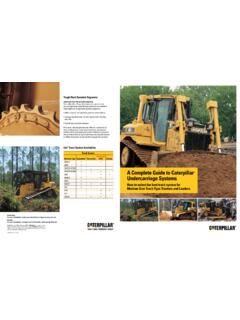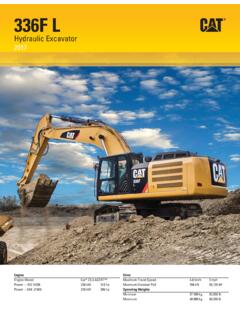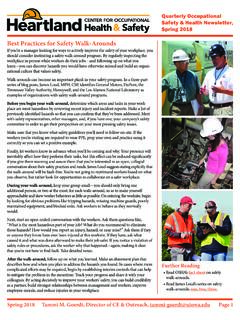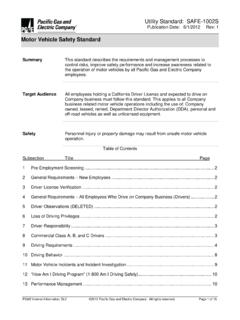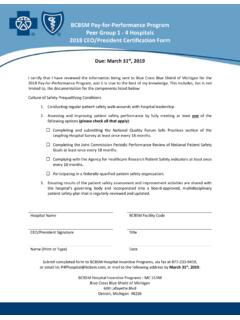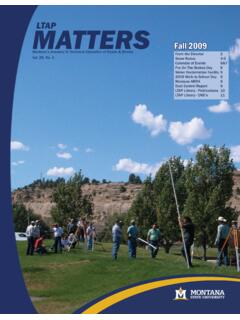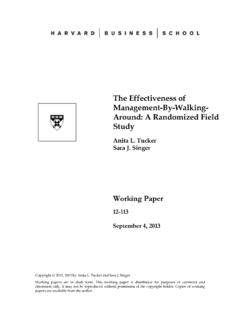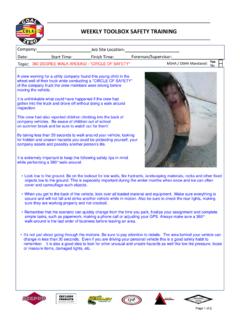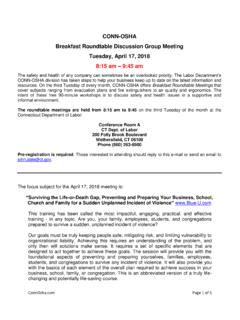Transcription of A SAfe OperAtiOn - Holt Cat
1 A SAfe OperAtiOnSAfety tipS fOr LAndfiLL JObSiteS43121. establish emergency plans and communicate to employees. As part of your safe daily operations, develop contingency plans and communicate these plans to the entire team. Teams helping perform face operations need to maintain constant communication with each other. Current operators changing machines on lunch breaks or shift breaks need to communicate with the replacement operator the machine condition and working hazards. Communication is key to maintaining safe Use proper personal protective equipment (ppe).
2 Safe landfill work requires training, knowledge and experience in operations and techniques. Understand what personal protective equipment (PPE) is necessary before starting a job and why. Personal protective equipment is meant to protect you and necessary for even the smallest, most fundamental tasks at a landfill. Hard hats, reflective safety vests, leather gloves and protective footwear, such as steel toed boots with slip-resistant tread, are examples of common PPE. It is important to wear sufficient clothing to minimize skin exposure, especially for those who have direct contact with waste, leachate or hazardous materials.
3 safety glasses and hearing protection should be worn on the jobsite. This type of protection reduces the risk of eye injuries and hearing loss. Consult your jobsite safety coordinator or foreman with PPE Wear your operators in a landfill are rarely traveling at high speeds, but it is important to remember seat belts do much more than simply protect the operator in the event of a collision. Seat belts also keep operators inside the cab s rollover protection structure (ROPS). Always check the condition of the seat belt and the condition of the mounting hardware before you operate the machine.
4 During the compaction process, landfill terrain is uneven and unstable, increasing the risk of machine rollovers. Staying buckled up keeps you in the ROPS and keeps you practice fire prevention at the landfill is responsible for being aware of and reporting: fires in the landfill, on machines and potential fire hazards. Fire poses a significant risk on landfill jobsites. To minimize this risk, check incoming loads for signs of fire, such as smoke, odors or flames. Ensure fire extinguishers are available on each piece of equipment and all operators are properly trained to use the device.
5 Select the appropriate type of fire extinguisher for your equipment. Fire extinguishers should be selected based on the classes of anticipated fires and the degree of hazard that would affect their use. If a fire occurs within the disposal area, immediately remove the waste even after the fire has been extinguished. The waste could continue to smolder causing sparks to be spread throughout the landfill area. Sparks could land on the machine or be pulled into the machine by the cooling fan. Emergency Response Plans should be on file with the local fire department and emergency medical responders so they can familiarize themselves with your site and emergency procedures.
6 Prevent fires on landfill machines Follow correct walk around procedures. Remove/clean materials/debris from heat sources. Shut the master switch off at the end of the fire extinguishers operate using the following technique1. pULL - Pull the pin. This will also break the tamper AiM - Aim low, pointing the extinguisher nozzle (or its horn or hose) at the base of the fire. NOTE: Do not touch plastic discharge horn on CO2 extinguishers. It gets very cold and may damage SQUeeZe - Squeeze the handle to release the extinguishing agent.
7 4. SWeep - Sweep from side to side at the base of the fire until it appears to be out. Watch the area. If the fire re-ignites, repeat steps 2-4. 5. be aware. know your surroundings. Many accidents occur when ground personnel and equipment operators fail to follow the existing basic safety procedures at the landfill. Visibility is crucial when working in a landfill. Landfill employees are responsible for knowing their surroundings, such as traffic flow and machine operations in the work areas. Ground personnel need to have the attitude of see and be seen!
8 Visual contact with all traffic and machines is a must. Constant visual scans of the work area are irreplaceable and should be instilled through training and leadership in each operator. 6. perform walk around proper walk around inspections of the machine a minimum of three times a day:1. At the beginning of the shift; 2. At the end of the shift; 3. Any time you dismount the machine. Look for leaks, potential fatigue failures, progressive component failures or major equipment failures on your machine.
9 Not only will inspections help to maintain the integrity of the equipment, but it will also help keep the equipment safe for inspections allow the operator to check for and rid the machine of debris build-up. Built up debris is a major safety concern because it is potential fuel for a fire. Simply noticing the accumulation of debris is not enough. It is your duty to maintain your machine s cleanliness for safe operations. If you see something that is unsafe or that could lead to a safety concern during OperAtiOn , write it down on your daily trip report and notify your supervisor or foreman.
10 Visit or the equipment maintenance manual for inspection checklists. Before approaching any vehicle/machine: Make eye contact with the operator. Give a hand signal to approach. Receive acknowledgement from the driver/operator before approaching. CheCkLiStWhy perform walk around inspections: To ensure the machine is performing safely for the jobsite and operating conditions. To inspect the machine for any faults that may require immediate attention. To identify problems or areas that require attention that can be planned and scheduled for the next opportune time or immediate ArOUndS971087.
